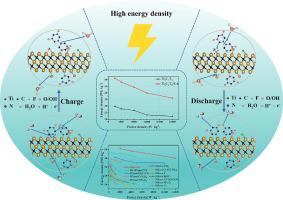Chemical Engineering Journal ( IF 13.3 ) Pub Date : 2023-04-12 , DOI: 10.1016/j.cej.2023.142935
Chao Feng , Bingzhe Jia , Han Wang , Yan Wang , Xinming Wu

|
Ti3C2Tx (MXene) are attractive for electrode materials because of their high electrical conductivity, abundant interlayer ions and low density. However, the low energy density hinders its commercial application. Herein, a novel N-doped Ti3C2Tx MXene is synthesized by introducing a small organic molecule dicyandiamide (DCD) to tune the complex terminals. DCD can be inserted into the layers of Ti3C2Tx nanosheets while forming melamine by catalyst-free trimerization reaction. Then, melamine is converted into gt-C3N4 through high-temperature sintering. Finally, gt-C3N4 is oxidized to cyanuric acid (CA) through simple hydrothermal reaction. The prepared Ti3C2Tx/CA composite electrode exhibits up to 4.8 at.% nitrogen doping and has a stable triazine ring structure. It is also shown that the Ti3C2Tx/CA composite electrode has high specific capacitance and excellent cycling stability. More notably, it achieves an energy density of 51.1 Wh kg−1 at a power density of 2000 W kg−1, which exceeds the energy density of MXene based electrodes reported in the current literature. This excellent performance is attributed to the unique hydroxyl structure of the CA terminal and the excellent symmetry of CA in the composite electrode. In aqueous electrolytes, CA can form short chains during charging and the formation of short chains enables the storage of electrons and further provides a large number of new pseudocapacitive reaction sites for MXene. At the same time, the high electronegativity of the N and O atoms in CA also increases the electric double layer capacitor of the composite electrode to a certain extent, thus resulting in a high energy density of the composite electrode.
中文翻译:

高能量密度超级电容器的新策略:在 Ti3C2TX (MXene) 夹层混合电极之间形成氰尿酸
Ti 3 C 2 T x (MXene) 因其高导电性、丰富的层间离子和低密度而成为电极材料的热门材料。然而,低能量密度阻碍了其商业应用。在此,通过引入小有机分子双氰胺 (DCD) 来调节复杂的末端,合成了一种新型的 N 掺杂 Ti 3 C 2 T x MXene。DCD可以插入到Ti 3 C 2 T x纳米片层中,同时通过无催化剂三聚反应形成三聚氰胺。然后,三聚氰胺转化为gt-C 3 N 4通过高温烧结。最后,gt-C 3 N 4通过简单的水热反应被氧化成氰尿酸(CA)。制备的 Ti 3 C 2 T x /CA 复合电极显示出高达 4.8 at.% 的氮掺杂并具有稳定的三嗪环结构。还表明Ti 3 C 2 T x /CA复合电极具有高比电容和优异的循环稳定性。更值得注意的是,它在 2000 W kg -1的功率密度下实现了 51.1 Wh kg -1的能量密度,这超过了当前文献中报道的基于 MXene 的电极的能量密度。这种优异的性能归功于CA末端独特的羟基结构和CA在复合电极中的优异对称性。在水性电解质中,CA 可以在充电过程中形成短链,短链的形成能够存储电子,并进一步为 MXene 提供大量新的赝电容反应位点。同时,CA中N和O原子的高电负性也在一定程度上增加了复合电极的双电层电容,从而导致复合电极具有高能量密度。

































 京公网安备 11010802027423号
京公网安备 11010802027423号